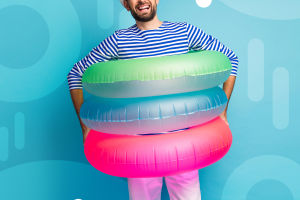A life buoy is a life-saving device, usually made of plastic or foam material, in the shape of a ring or oval. It is widely used in swimming pools, beaches, lakes, rivers, and other waters to provide emergency rescue for drowning people.
The lifebuoy can keep the person in the water safe by throwing it at the person who falls into the water, causing them to cling to the lifebuoy and swim towards the shore. It can also be used as a buoyancy device. In an emergency, the person in the water can grab the life buoy and keep the part above the head above the water to wait for rescue.
To improve rescue efficiency, modern life buoys are usually attached to lifelines or rescue equipment, such as life rafts or life jackets. Additionally, some lifebuoys are fitted with reflective material to make them easier to spot in low-light conditions.
The material of the life buoy usually has the following types:
PVC material: This material is often used on small lifebuoys in children's swimming pools and water parks because it is lightweight, durable, and relatively affordable.
Foaming material: such as polyethylene, polyurethane, etc., this material is usually used in large swimming pools, beaches, water parks, and other occasions. It has high buoyancy and waterproof performance, which can float in the water and keep people safe.
Inflatable material: This material is made of waterproof and durable material, which can be inflated during use to make it better buoyancy and stability, and is usually suitable for rescue use in outdoor sports such as swimming and rowing.
Polymer material: This material is the most advanced lifebuoy material at present, with good tensile strength, wear resistance, and waterproof performance, and can be used in harsh climates and environments.
Lifebuoys and swimming rings are commonly used water lifesaving equipment, but they are very different:
The design purpose is different: the lifebuoy is a kind of equipment specially designed for emergency rescue, and it is usually used to rescue those who fall into the water so that they can surface and remain safe. A swimming ring is an auxiliary tool used to help swimmers maintain buoyancy and balance.
Shapes and sizes vary: lifebuoys are usually round or oval, with a larger diameter and hollow or foam-filled interiors to provide greater buoyancy and stability. The swimming ring is circular, with a relatively small diameter, usually made of plastic or rubber, and has relatively little buoyancy.
Applicable people are different: lifebuoys are usually suitable for people who are unskilled or unable to swim, or those who fall into the water or need rescue while swimming rings are suitable for people who need assistance to maintain buoyancy and balance.
With the application of new technologies and materials, various life-saving equipment emerge in an endless stream: lifeboats, life jackets, everything you expect to find.
But this traditional equipment of life buoy is still used by people and is still a kind of simple life-saving tool.


